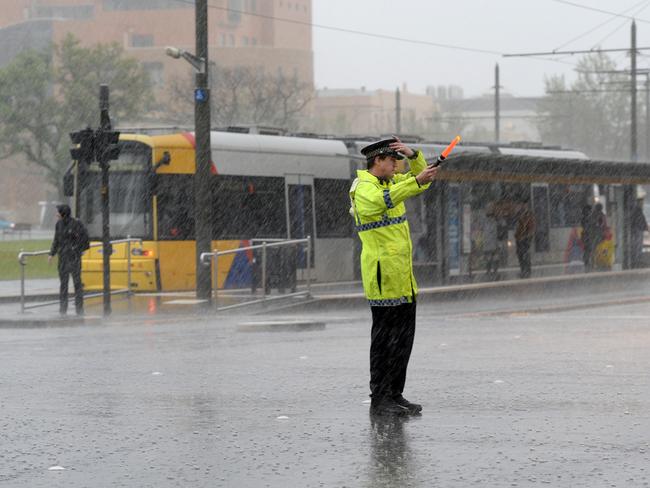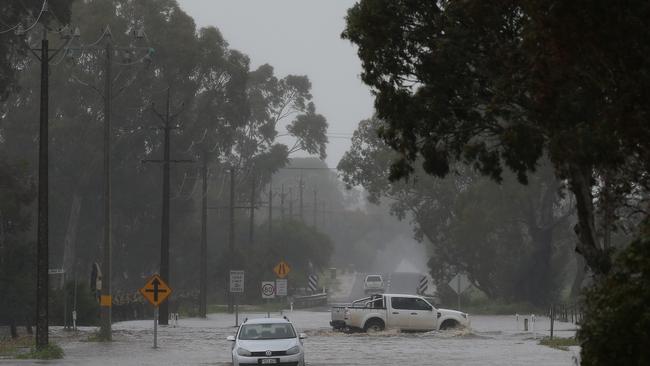South Australia bracing for more destruction with monster 140km/h wind system set to bear down on state
SOUTH Australia faces further destruction today as a massive storm continues to lash Adelaide and the rest of the state.
- ROLLING COVERAGE: Latest on SA’s wild weather
- HOW IT HAPPENED: How we reported the day’s events
- WHAT’S COMING: State faces 140km/h wind
- LIGHTNING: Shards fly as car gets fried
- GALLERY: Storm wreaks havoc across state
SOUTH Australia faces further destruction today as a massive storm continues to lash Adelaide and the rest of the state.
KEEP UP TO DATE WITH OUR ROLLING STORM COVERAGE ON THE PULSE
The weather bureau is expecting gale-force winds, up to 40mm of rain to fall in the city and possible further isolated thunderstorms before the storm eases.
But the respite won’t last for long. This afternoon and this evening, a secondary low with the potential for damaging winds and rainfall is due to sweep the state, including Adelaide, later today.
Huge areas of the state were blacked out, soaked and smashed by destructive winds and golf ball-sized hail as two powerful storms swept across the state from Western Australia on Wednesday.
The storms were followed by an intense low-pressure system that has wreaked havoc from about midnight last night.
Weather bureau meteorologist Julie Guerin said although the “real story” happened overnight as the low hit South Australia, it wasn’t over yet.
She said severe winds were moving clockwise around the low and would be damaging.
“These are mean winds that will come through Adelaide,” Ms Guerin said.
In Adelaide, the winds were expected to hit speeds of up to 75km/h with isolated gusts of 120km/h.
Gusts on the western coast of the state were expected to hit 140km/h.
Ms Guerin said the state would experience more rain with up to 60mm expected to hit Adelaide overnight and into today, while the Hills could expect up to 100mm.
A warning also has been issued for abnormally high tides.
The bureau said the high-tide warning was current for the Spencer Gulf and Gulf St Vincent, where tides were expected to reach about 1m higher than some of the highest tides of the year.
Tides at Outer Harbour could reach up to 3.8m and sea water could flood low level areas.
HOW THE MONSTER STORM SWEPT SA
Wednesday’s storm was thought to be one of the worst storms to hit the state in decades. The city and towns across SA were thrown into chaos as the two main rainbands moved across from the west.
At least two homes and a church in Blyth in the state’s Mid North sustained significant damage when a storm lashed the town about 3.45pm yesterday.
The first storm front caused flooding in Whyalla after just an hour of rain, hitting just before lunchtime on Wednesday.

It then swept rapidly across Adelaide. One of the worst-hit areas was Cleve, on the central Eyre Peninsula, which was pummelled by golf ball-sized hail.
The next major burst of rain and thunderstorm struck the city about 3.45pm.
Between 9am and 6pm, the city had been hit by about 20mm of rain, while Mt Lofty had a 33mm-soaking.
The entire state was blacked out as the second band swept across SA.
The State Emergency Service responded to 404 incidents up to 7pm yesterday as crews worked hard to patch up leaking roofs, chop up fallen trees blocking roads and prevent homes being flooded.
Houses shook and debris was thrown for 50m in all directions after lightning struck a car and tree, rocking a quiet Myrtle Bank street yesterday morning.
House owner Emma Altman said her son and elderly mother had been in the house when the lightning struck a nearby tree.
“They heard the lightning strike and the house shook, then the branch landed on the house,” she said.
Cleve resident Aileen Hampel said large hail stones so big that they broke a window had pelted the Eyre Peninsula town about 1.30pm.
“It started off with little hail and then it was big and I ended up getting a broken window,” she said.
STORM LEAVES STATE REELING FROM OUTAGES
By Paul Starick
AUTHORITIES were are fighting to restore power to South Australia to avert chaos caused by an unprecedented statewide power blackout triggered by outages at nine Mid North transmission towers and three high-voltage lines.
Havoc gripped the state after the electricity network “tripped” at 3.48pm on Wednesday afternoon, plunging workplaces into darkness, forcing hospitals to emergency generators and paralysing public transport and peak-hour traffic.
It is understood the crippling shutdown was caused by the high-voltage towers’ and transmission lines’ outage causing cascading system-wide shutdown — similar to a home safety switch cutting off household supply.
Efforts to restore supplies were hampered by so-called network underfrequency, or unstable supply, because gas-powered generators were running at limited capacity.
In a politically charged situation, intermittent generation from wind farms was supplying between 1100-1200 megawatts of the state’s 1900MW electricity consumption at the time of the blackout.
This will provoke further accusations the state has been left dangerously exposed by the State Government’s renewable energy push, partly blamed for the closure in May of Port Augusta’s power station.

Electricity was restored to swathes of suburbs by Wednesday night as authorities began to rebuild the power network by gradually turning on gas-fired power stations such as Torrens Island and Pelican Point, with close to 400MW online by 7.30pm.
National business groups condemned the “potentially catastrophic” situation, declaring it would erode confidence and branding it unacceptable in a first-world country.
Premier Jay Weatherill blamed the severe storms lashing the state, saying the blackout would have happened even if Port Augusta power station had been operating, and warned against playing politics with a statewide emergency.
In extraordinary scenes:
SHOPS and businesses were forced to close.
TRAFFIC light failures triggered mass gridlock across the city during peak hour.
PASSENGERS were stuck in trams, and trains were not working.
HOSPITALS were operating on emergency generators, prompting warnings for only emergency patients to attend.
STUDENTS from at least one school were told not to turn up today.
PEOPLE were trapped in lifts at the Royal Adelaide hospital and in at least one CBD office tower.
SA WATER was unable to pump sewage in some areas.
Mr Weatherill late yesterday said power gradually would start being restored, stressing the high-voltage interconnector cable to Victoria was still operating, but said no detailed predictions of time frames had been supplied.
“It is likely that the southern part of the state, that is south of the break will be restored first, the northern part of the state is likely to take longer,” he said..
“This is a major weather event and the system has reacted a it is supposed to react. The system operates in this way to shut the system down and is now being restored in regard to those protocols.
“This would have happened in any circumstance, even if we had the Northern power station up and running. For people to be saying those things without being actually appraised of all the facts demonstrates that people are using this to play politics instead of responding to what is a state emergency. It is regrettable that people would leap to a political criticism at this time.”
The state’s high-voltage network operator, ElectraNet, late yesterday said electricity power restoration times were unknown but predicted it would take several hours.
“We understand the impact of this event and are working hard to resolve it,” a company statement said.
“Given the severe weather events and potential damage to electricity infrastructure, members of the public should be alert to the potential for powerlines and associated equipment to be damaged.”
Major employers were on the verge of shutting down because of dwindling supplies and soaring prices during another power crisis in July, prompting the State Government to plead with Pelican Point power station operators to renew generation.
The state’s world-leading reliance on renewable energy, particularly wind, has sparked widespread accusations that the network has been left dangerously prone by a reliance on intermittent generation and lack of baseload gas or coal-fired generators.
Federal Energy Minister Josh Frydenberg said serious questions would be raised about how all of SA could be left without electricity in the wake of a huge storm, dubbed the largest in 50 years.
“Clearly, questions will be raised, serious questions will be raised, that need to be answered as to how this extreme weather event could take out the whole of the electricity supply across a major state such as South Australia,” Mr Frydenberg said..
“There are actually two interconnectors between Victoria and South Australia - one’s called the Murray link and the other one is called the Heywood interconnector, and the recent spike in prices in the South Australian spot market for electricity was due in part to the upgrade to that interconnector.”
Opposition Leader Steven Marshall said serious questions must be answered by Mr Weatherill and state Energy Minister Tom Koustantonis.
Australian Industry Group chief executive Innes Willox said the outage, whatever the cause, showed SA no longer had a plan B for electricity.
“The result has been potentially catastrophic for business and many costly stories will no doubt be heard in the coming days,” he said.
“It will, sadly, further damage confidence. This is not what you would expect in a first-world country.”
Influential South Australian Senator Nick Xenophon urged an independent inquiry
“This is a disgrace. How did this happen? How is an entire state blacked out?,” he said.
“This has not been sensible, it has been reckless — we have relied too much on wind rather than baseload renewables, rather than baseload power, including gas which is a fossil fuel but it is 50 per cent cleaner than coal and a good transitional fuel. We need a full independent inquiry. ”
The Australian Energy Market Operator, which operates the nation’s electricity network, said SA’s power grid had been isolated from other states.
“AEMO is working closely with transmission network service provider ElectraNet to identify and understand the severity of the fault,” a statement said.
with Mitch Mott, Andrew Hough, Luke Griffiths, Katrina Stokes, Sheradyn Holderhead.

